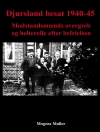Cold War history has emphasized the division of Europe into two warring camps with separate ideologies and little in common. This volume presents an alternative perspective by suggesting that there were transnational networks bridging the gap and connecting like-minded people on both sides of the divide. Long before the fall of the Berlin Wall, there were institutions, organizations, and individuals who brought people from the East and the West together, joined by shared professions, ideas, and sometimes even through marriage. The volume aims at proving that the post-WWII histories of Western and Eastern Europe were entangled by looking at cases involving France, Denmark, Poland, Romania, Switzerland, and others.
Cuprins
List of Illustrations
Introduction: Beyond the Divide
PART I: POLITICAL PROCESSES AND TRANSNATIONAL NETWORKS
Chapter 1. Opening Up Political Space: Informal Diplomacy, East-West Exchanges, and the Helsinki Process
Giles Scott-Smith
Chapter 2. Challenging Old Cold War Stereotypes: The Case of Danish-Polish Youth Exchange and the European Détente, 1965–75
Marianne Rostgaard
Chapter 3. Transmitting the “Freedom Virus”: France, the USSR, and Cultural Aspects of European Security Cooperation
Nicolas Badalassi
Chapter 4. Cultural Diplomacy of Switzerland and the Challenge of Peaceful Coexistence, 1956–75
Matthieu Gillabert
PART II: INTERPLAY IN THE ACADEMIC CONTEXTS
Chapter 5. Expert Groups Closing the Divide: Estonian-Finnish Computing Cooperation since the 1960s
Sampsa Kaataja
Chapter 6. French-Romanian Academic Exchanges in the 1960s
Beatrice Scutaru
Chapter 7. Hungary Opens toward the West: Political Preconditions for Finnish-Hungarian Cooperation in Research and Development in the 1960s and 1970s
Anssi Halmesvirta
Chapter 8. “Discrete” Intermediaries: Transnational Activities of the Fondation pour une entraide intellectuelle européenne
Ioana Popa
PART III: LIMITATIONS FOR TRANSNATIONAL NETWORKS
Chapter 9. The Image of “Real France”: Instrumentalization of French Culture in the Early Communist Czechoslovakia
Václav Šmidrkal
Chapter 10. Dealing with “Friends”: Soviet Friendship Societies in Western Europe as a Challenge for Western Diplomacy
Sonja Grossmann
Chapter 11. The Soviet Union Encounters Anglia: Britain’s Russian Magazine as a Medium for Cross-Border Communication
Sarah Davies
PART IV: ALONG THE BORDERLINES
Chapter 12. Transnational Television in Europe: Cold War Competition and Cooperation
Lars Lundgren
Chapter 13. Transnational Spaces between Poland and Finland: the Grassroots Dismantling of the Iron Curtain and Their Political Entanglements
Anna Matyska
Chapter 14. A Filter for Western Cultural Products: The Influence of Italian Popular Culture on Yugoslavia, 1955–65
Francesca Rolandi
Notes on Contributors
Bibliography
Index
Despre autor
Pia Koivunen is lecturer in European and World History at the University of Turku. She is currently completing a monograph on the World Youth Festival and Soviet Cultural Diplomacy; and another book on individuals’ experiences on traveling to Eastern Europe during the Cold War years.












